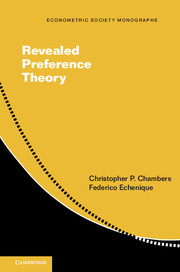Book contents
- Frontmatter
- Dedication
- Contents
- Preface
- 1 Mathematical Preliminaries
- 2 Classical Abstract Choice Theory
- 3 Rational Demand
- 4 Topics in Rational Demand
- 5 Practical Issues in Revealed Preference Analysis
- 6 Production
- 7 Stochastic Choice
- 8 Choice Under Uncertainty
- 9 General Equilibrium Theory
- 10 Game Theory
- 11 Social Choice and Political Science
- 12 Revealed Preference and Systems of Polynomial Inequalities
- 13 Revealed Preference and Model Theory
- References
- Index
- Miscellaneous Endmatter
6 - Production
Published online by Cambridge University Press: 05 January 2016
- Frontmatter
- Dedication
- Contents
- Preface
- 1 Mathematical Preliminaries
- 2 Classical Abstract Choice Theory
- 3 Rational Demand
- 4 Topics in Rational Demand
- 5 Practical Issues in Revealed Preference Analysis
- 6 Production
- 7 Stochastic Choice
- 8 Choice Under Uncertainty
- 9 General Equilibrium Theory
- 10 Game Theory
- 11 Social Choice and Political Science
- 12 Revealed Preference and Systems of Polynomial Inequalities
- 13 Revealed Preference and Model Theory
- References
- Index
- Miscellaneous Endmatter
Summary
Production theory is another classical environment in which revealed preference theory is applied. The case of production is simpler than the case of demand treated in the previous chapters, mainly because firm output is a cardinally measurable and observable concept, whereas utility is not. In the case of production, we shall assume that firm output and prices are both observed, while the set of all feasible production vectors, that is the firm's technology, is not.
We will consider two approaches to production theory: the cost minimization model and the profit maximization model. In the first model, factor prices and factor demands are observed, and (single-dimensional) output is observed as well. This environment is very similar to the consumer case, but, as we have noted, simpler. We want to know whether the model is consistent with the cost minimization hypothesis, meaning that the cost of production is minimized for a given level of output.
In the second model, the model of profit maximization, we want to test the hypothesis that producers maximize profit. This model is in a sense “dual” to the consumer case. In the consumer case, we needed to solve for the function being maximized, but we know the budget set. In contrast, in the producer case, we know the function being maximized: it is a linear profit function; but we do not necessarily know the available technology (the constraint set faced by the firm).
COST MINIMIZATION
We take as primitive a dataset comprising the input–output decisions of a firm. The firm uses n factors, and produces a single good. An input–output dataset D consists of a collection (yk, xk,pk), k = 1, …, K, where yk ∈ R, xk ∈ Rn+, and pk ∈ Rn++. Each observation k consists of a quantity of output yk, a vector of factor demands xk, and factor prices pk. Note that output can be negative, but inputs are always positive.
- Type
- Chapter
- Information
- Revealed Preference Theory , pp. 83 - 94Publisher: Cambridge University PressPrint publication year: 2016



